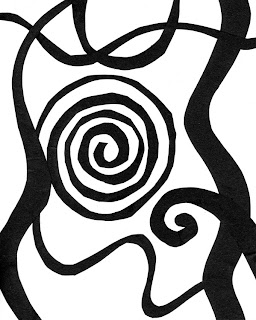"The best way to learn what a line can do is to experiment with it. You must take a line and move it around on a page, discovering for yourself what happens as its position changes."
For this non-objective project, I had to measure and cut my bristol paper into an 8'' x 10'' format. (Which is actually a lot easier said than done when using an X-acto knife.) Next we had to cut black strips of construction paper and arrange them in a unique and visually exciting way that developed interest in how the ground was divided. This project concentrated mainly on line and the figure-ground relationship.
For the first piece posted, I could only use diagonal lines. I remember cutting out tons of strips of paper and rearranging them multiple times, and then cutting out more of different thickness and length that I felt would work. I ended up not using a lot that I had cut out simply because I felt that I had accomplished an exciting design without overloading it with line. I liked the figure-ground relationship that I had created and how there was more ground apposed to black figure. I also constantly turned the piece around over and over again trying to figure out the best way to view it.
The second posted piece only used curved, fluid, and organic lines. This is actually the second piece that I had made, and I felt it was more successful than my first try. With the first one I used my x-acto knife to cut out the curved strips of black construction paper. After I had glued my pieces down using rubber cement I realized that it wasn't what I had hoped. So for this one I cut the pieces out using scissors, which actually worked out a lot better for me. With this one again I viewed it from all sides to find the best point of view. Overall, I was very pleased with this project.


No comments:
Post a Comment